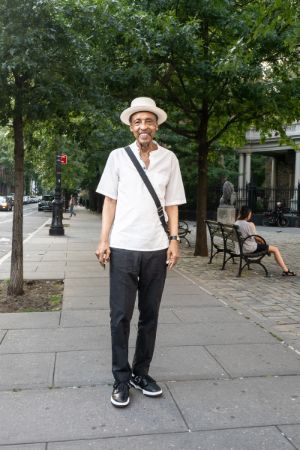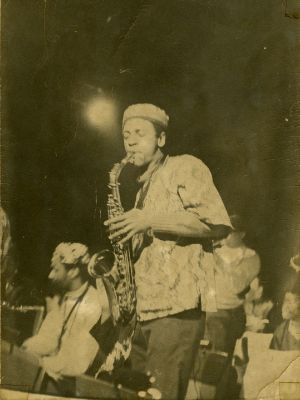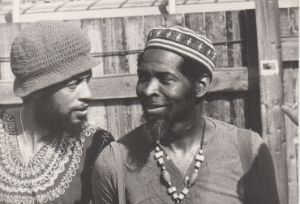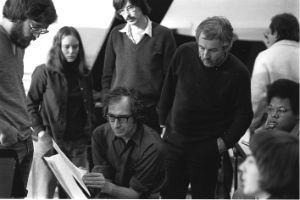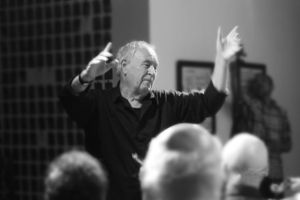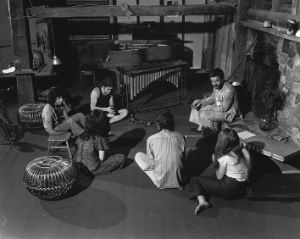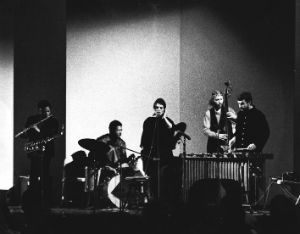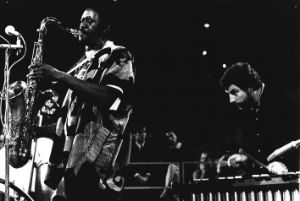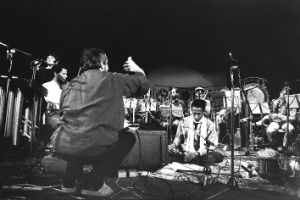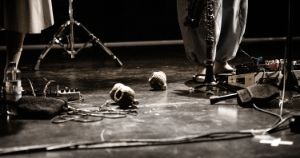
© Anna Niedermeier
(Un-)Learning Jazz
Teaching and learning jazz and improvised music appears to be full of contradictions. Jazz culture cherishes its ideals of spontaneous creativity and originality, however, “learning” to master these requires a degree of following the rules. In academic teaching in particular, it hardly seems possible any longer to reconcile the weight of tradition with the idea of liberation from everything conventional and teachable that is inherent, for instance, to free improvisation and some traditions of free jazz. At the same time, communicating what jazz is assumes it has a defined spectrum of playing techniques and formal conventions – in other words: genre boundaries. However, these are something that jazz has a long tradition of breaking.
The following features with and about the artists in Jazzfest Berlin 2023 explore these tensions, partly by asking some very concrete questions: how does education work both in academies of music and on a basic level with children? Which criticisms of the academic system are justified, and which are pure jazz populism? Three chapters cover different aspects: “(Un-)Teaching Improvisation” deals with conveying musical improvisation skills between academic institutionalization and musicians learning informally from each other. “(Un-)Classifying Music” examines the approach of “creative music”, which attempts to overcome patterns of identification that continue to be associated with the word “jazz” but were imposed by a predominantly white music industry – and offers insights into Henry Threadgill’s distinguished role in creative music as well as a taster of his co-operation with Silke Eberhard’s Potsa Lotsa XL at this year’s Jazzfest Berlin. A brief homage to Karl Berger consisting of photographic impressions and some affectionate words by his wife Ingrid Sertso reminds us of the work as both mentor and musician of the co-founder and head of the Creative Music Studio who died earlier this year. And “(Un-)learning to Play” illuminates the background to two projects in the festival programme that highlight the processes of creative work by and with children.
1
(Un-)Teaching Improvisation
It is widely held that, more than anything else, improvisation epitomises unpredictability and spontaneity, communication, playfulness and intuition, originality and innovation – things that are usually difficult to learn. Is jazz in danger of losing its intuitive and progressive nature as a result of its gradual institutionalisation as a teachable element of “high culture”? And to what extent do musicians have to unlearn what they have taken the trouble to learn in universities and conservatoires in order to find their own individual artistic identity?
After an essayistic introduction, Thomas Gläßer and Marlies Debacker explore in a podcast what improvising musicians can (un-)learn by engaging with tradition and the canon of jazz and new music and whether academic study is fundamentally detrimental to an intuitive understanding of music. In a video interview with Peter Margasak, Fred Frith shares some of his lengthy experience as Professor of Free Improvisation at Mills College in California, talking among other things about the obstacles and contradictions he has encountered in this capacity. The saxophonist Marthe Lea recalls key steps in her process of self-discovery as an artist, placing herself both inside and outside a Norwegian education system regarded as especially supportive of creativity. And in a conversation with Peter Margasak, Andrew Cyrille describes a time when jazz was still a thoroughly oral tradition that was learnt in what he refers to as the “conservatory of the streets”: in clubs and marching bands, playing a range of polkas, merengue, calypso, bebop and cool jazz, and by listening to, copying and mixing with the sounds of the city and the greats of the local scene.
“Trying to learn as much as you can and then forget as much as you can when you go on stage – it’s an eternal paradox.”
Marlies Debacker
Teaching and learning jazz - between discursiveness and creative transgression
by Thomas Gläßer
Jazz is a hybrid form of music: popular, artistic, academic, part of a subculture, conservative, transgressive, spontaneous, constructed. Perhaps it is not always all of these at the same time, but often flickers between different qualities, alternating between the stabilising influence of a genre identity and an impulse towards creative transgression to become a definition-transcending “creative music” – to quote one term that was first used in the 1960s by a series of musicians, composers and collectives in the USA to describe the works they were producing informed by jazz and Black traditions, contemporary experiments in European art music and non-European musical cultures.
The methods of working and absorbing material, processes of learning and reserves of knowledge that supported this development and made it possible are as multi-faceted as this “creative music” itself. While jazz’s early history was largely characterised by informal processes of learning in bands and ensembles, starting in the USA from the mid-1940s, more and more academies of music, colleges and conservatoires began to offer “academic” jazz training. These soon attracted criticism for their marked tendency towards a standardisation of the repertoire and methodical approaches and were accused, amongst other things, of streamlining jazz and of making it appropriable in a superficial way, robbing it of its authenticity, its dynamic of artistic self-empowerment and its emotional power.
In Conversation with Marlies Debacker
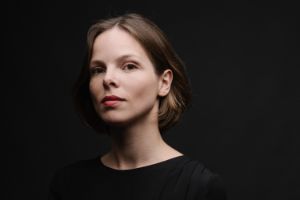
Since she was a student at the Hochschule für Musik und Tanz Köln, the Belgian pianist Marlies Debacker has been an unmissable part of Cologne’s contemporary music scene. Debacker represents a new generation of musicians who devote themselves equally to the art of improvisation and to composed music, skilfully combining the two. In conversation with Thomas Gläßer she talks about how to develop the ability to imagine sound in your head and then realise it in practice, about physicality and not knowing while you are playing and about contradictions that repeatedly have to be resolved.
In Conversation with Fred Frith
The British guitarist and improviser Fred Frith is one of the greats of experimental music and helped to launch experimental rock in the 1960s with the group Henry Cow. Along with his fellow band members, his activities spanned a range of musical fields – from improvisation through electro-acoustic experiments to compositions for film, theatre and dance. Frith played in numerous different bands, collaborated with artists from a variety of disciplines and until 2020 taught at Mills College in Oakland, California – one of the epicentres of experimental music in the USA. In an interview he tells the author and music journalist Peter Margasak how the teaching of improvised music in the USA has changed and what influence his work as a university teacher has had on him as a musician.

Subtitles are available in German and English. Turn on the subtitles by selecting the CC icon in the lower right corner of the player and choose a language.
In Conversation with Marthe Lea
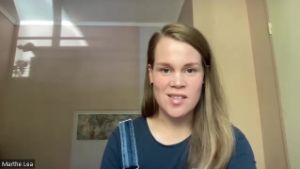
Subtitles are available in German and English. Turn on the subtitles by selecting the CC icon in the lower right corner of the player and choose a language.
The highly energetic compositions of the Norwegian multi-instrumentalist and singer Marthe Lea are a cornucopia of musical influences, inspired by Norwegian folk music, Ethiopian soul and Moroccan Gnawa grooves. Her performances are full of spontaneity and an enormous joy that she shares with her fellow musicians – who are all multi-instrumentalists too. She talks to Peter Margasak about her time at the Norwegian Academy of Music in Oslo and the challenge to combine conducting as a bandleader and the ecstasy of letting go on stage.
Andrew Cyrille
Few living jazz musicians have been involved in as much history-making as Andrew Cyrille, who will celebrate his 84th birthday five days after his performance at Jazzfest Berlin 2023. Famous for his formative role in the development of free jazz, which included being one of Cecil Taylor’s most visionary percussionists, in a way Cyrille carries the entire history of jazz inside him: as a teenager he spent a lot of time with musicians like Philly Joe Jones and Max Roach and he played gigs that spanned the whole cultural spectrum of the musical traditions that he encountered in his native New York. In an interview with Peter Margasak he talks about learning from older generations, the school of “bandstands” and his work as a professor.
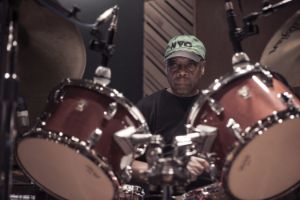
Andrew Cyrille
© Marek Lazarski
Andrew Cyrille in Conversation with Peter Margasak
Peter Margasak: You’re of a generation that was learning on a bandstand. Obviously, Philly Joe Jones was a big mentor for you early on. But then you went to Juilliard and you’ve taught yourself for a long time. These two different systems of oral tradition on the one hand, learning directly from musicians, and on the other hand a university system where jazz is taught – you’ve both in your rich background. I know that you started playing in school in a drum and bugle corps. Was that the first time you played music or did you have drums around the house as a kid?
Andrew Cyrille: We had a piano in the house, I’d bang on that. I was never given any actual lessons by a piano teacher. These were given to my sister, who was a little older than I was. When I came along, my mother decided to give the piano to a club that she belonged to, so that was out of the house. But I used to bang on pans in my backyard a little later on. That was when I was 7 or 8 years old. Music has always been in my life. My mother used to sing a lot and turn the radio on in the morning when we got up to school. At school, there was the German People Corps and that enticed me to continue to play, to learn more about drumming because of musicians who were older and actually from the jazz tradition. Along with playing marching music for a drum and bugle corps, they also told me that there are other ways to play drums. I was introduced to the trap drum set. That again sparked my interest in learning how to play an instrument that was different because you engaged all four limbs simultaneously.
Peter Margasak: When did you get your first drum kit?
Andrew Cyrille: I got my first drum kit when I was a freshman in high school. I bought it from a neighbour living around the corner. He had an old set of drums that Chick Webb would play and Zutty Singleton, people like that, so a big bass drum. The bass drum had a light inside of it, which would make the drum head on front light up. After that, I got a drum set that was of the kind that Charlie Persip, Art Blakey, Roy Haynes, Philly Joe Jones played. So that was the first real “drum set” that I began to use on jobs when I was a teenager and I’m using that kind of set up to this day.
Peter Margasak: For your own education and for learning how to play drums, how important were those experiences of hanging out, listening and talking to people that were the greats of the time?
Andrew Cyrille: That was another facet of what education is, which teaches one how to think – from looking and listening and sometimes talking to those people about how to play that kind or genre of music, which was not taught in the conservatory. One could call it the University of the Streets. That was also a conservatory because they had learned what they played from previous generations. The word ‘conservatory’ just simply means that you conserve what has gone on before you. So when you go to the conservatory, like Juilliard or Manhattan, they are just saving stuff that had been played by other people in the past – Bach, Beethoven, Mendelssohn, whomever. I’m not saying that they don't have creative aspects to the university systems. But you have to think about what the word ‘conservatory’ means or where it comes from. Me learning from people like Philly Joe Jones and watching and listening to Art Blakey and Max Roach and others, that was also a conservatory, but it hadn’t been institutionalized. Nowadays, to some degree it has. It has been put into, let’s say, an edifice, which is a building where people go and they learn what it was that I was taught and to get a degree for it. Because Max Roach and Philly Joe Jones, they didn’t give out degrees. The only degree you might get is when you got up on the bandstand and you did not only play, but you played the music well and they accepted this fact.
Concerts with Andrew Cyrille, Marlies Debacker, Fred Frith and Marthe Lea
▽ Scroll for more content
„I don’t really like the word jazz; I prefer creative improvised music, because there's confusion about what jazz means now.“
Henry Threadgill
2
(Un-)Classifying Music
It is sometimes necessary to (un-)learn not only the rules by which music is played but also the often stereotypical patterns of listening, thinking and action that mix musical and non-musical elements when applying labels such as “jazz” or “contemporary improvisation”.
A more open model, both in stylistic and social terms, lies behind the term “creative music”. In his essay, the musicologist, musician and jazz historian Harald Kisiedu places this concept – which has been prominently represented by the Association for the Advancement of Creative Musicians, amongst others – within a long tradition of rejections of the term jazz by musicians who wish to resist musical or social classification. A multimedia feature on the Pulitzer Prize-winner Henry Threadgill and his collaboration with Silke Eberhard at Jazzfest Berlin 2023 will also shed some light on the life and work of one of the most influential composers, multi-instrumentalists and forerunners of creative music – while reflecting on the role of history in contemporary music from a broader perspective. Finally, we will pay tribute to one of the great mentors of improvised music, the co-founder and life-long artistic director of the Creative Music Studio Karl Berger, his work and influence as a musician and as a pioneer of intuition and Flow in music – with a photo series and some affectionate lines in his memory by his wife and collaborator Ingrid Sertso.
(Un-)Learning Jazz
by Harald Kisiedu
The term “jazz” has been an unstable signifier from its very inception. What complicated things is the fact that many of the foremost “jazz”-identified practitioners such as Duke Ellington, Miles Davis, Ahmad Jamal, Max Roach, John Coltrane, Ornette Coleman, Yusef Lateef, Pharoah Sanders, and last but not least Henry Threadgill rejected the term. In doing so, they fundamentally challenged genre boundaries, racialized and constrained notions of linage and tradition as well as attendant limitations of mobility associated with the word “jazz” with regard to musical methods, concepts, and practices. This historical experience has inscribed itself in the term “jazz,” therefore, one might argue, precluding any viability of a purportedly innocent use of this term./p>
Spawned by the Black Freedom Movement’s call for social transformation by means of self-determination, on May 8, 1965, Muhal Richard Abrams, Jodie Christian, Phil Cohran, and Steve McCall co-founded the Association for the Advancement of Creative Musicians (AACM), a critically important collective of Black experimentalists on Chicago’s South Side. As George E. Lewis has established, during the association’s founding meeting the term “creative music” figured prominently with Abrams delineating one of the organization’s goals as follows: “We are promoting creative music as an art – culture.”[1]
By the early 1970s the term “creative music” had gained currency. The short-lived Creative Construction Company, an ensemble which included Anthony Braxton, Leroy Jenkins and Wadada Leo Smith a. o. recorded two eponymous albums in 1970. In 1973 Wadada Leo Smith published notes (8 pieces): source a new world music: creative music, a study which according to music theorist and AACM scholar Paul Steinbeck “was the very first English-language monograph about contemporary improvisation.”[2] In 1971, Karl Berger, Ingrid Sertso, and Ornette Coleman established the Creative Music Foundation whose main program by 1973 had evolved into the Creative Orchestra Studio, and in 1976 Anthony Braxton’s album Creative Orchestra Music was recorded and released.
By the late 1960s Henry Threadgill had joined the AACM and had begun teaching at the organization’s school. For the past 50 + years the Pulitzer Prize winning composer, musical thinker, and multi-instrumentalist has been on the forefront of creative music and has opened up new possibilities for non-corporate approved forms of Black expressive culture by changing the discourse surrounding the music. Threadgill might be viewed as the embodiment of an aesthetic stance which Oliver Lake has described as follows: “The term Creative Music expresses the fact that you are moving forward, you are searching, you are not standing still, you try to make things happen, you are using different elements of the music together, you don’t go to one spot and stay there.”[3]
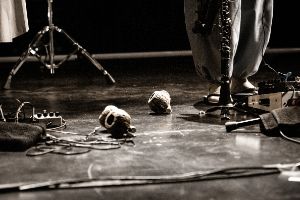
© Anna Niedermeier
Who speaks about whom?
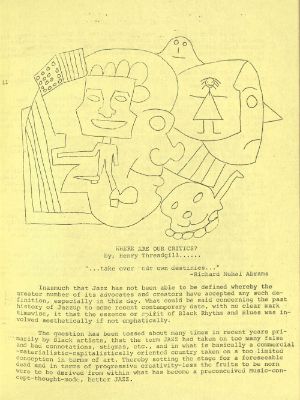
Henry Threadgill, “Where Are Our Critics?” The New Regime 1 (December 1968): p. 11-12.
Courtesy of Henry Threadgill
The article “Where are our Critics?” appeared in 1968 in the first issue of the AACM newsletter The New Regime. In it, Threadgill takes the growing discontent at the time, especially among Black artists, with the “false and bad connotations, stigmas etc.” of the term Jazz as well as the “too limited conception in terms of art” behind it as a point of departure for claiming interpretive sovereignty over the music for its “creators and performers”. While in “western Music History, some of the best critics and writers were themselves musicians and composers”, jazz journalism at the time, Threadgill argues, was characterized by the snobist sophistry and ideological platitudes of the “out-of-time-of-tune reviewers of society”, from whom “we cannot expect much good (…) other than creating a serious gap for a large number of people”. [1]
Five and a half decades later, in his recently published autobiography “Easily Slip Into Another World: A Life in Music”, where the article is reprinted in its entirety, Threadgill comments: “When I wrote this, I was a twenty-four-year-old private first class in the US Army, hardly just back from Vietnam. I had had my fair share of experience as a musician. But I hadn’t made a record yet, or finished my degree at the conservatory. Reading it again so many years later, what I find striking is how self-conscious I was about my own professionalization. And how clear I was about what was needed: not promotion, not commercial exploitation, not sensationalism, but instead honest and accurate information about who we were and what we were trying to do as serious artists. In the AACM we shared a conviction that (…) that information wasn’t going to come from journalists and critics. (…) Green as most of us were, we weren’t intimidated at the idea of having to become the historians and explicators of our own creativity.” [2]
A Henry Threadgill Playlist
by Brent Hayes Edwards
One of the most striking things about Henry Threadgill’s music is how different his bands sound from one another. As a composer he has been celebrated for his penchant for unusual instrumentation and for his infectious defiance of expectations. But his ensembles may also be unparalleled in the sheer range of their sound. The collective trio Air, his first great band in the 1970s, can be described as an exercise in minimalism – working with only reeds or flute, bass and drums, Threadgill was forced (as he once put it) “to learn to write the silhouette of the thing rather than the thing itself.” But by the middle of the decade, he also started composing for a large group, X-75, that startled listeners with its density, combining multiple basses, multiple flutes and a vocalist.
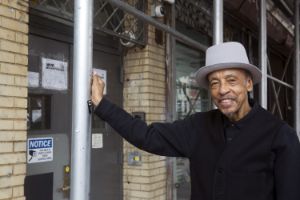
In Conversation with Silke Eberhard
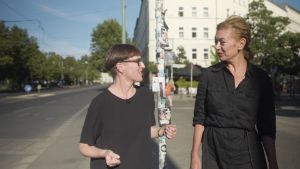
© MOJA film
Subtitles are available in German and English. Turn on the subtitles by selecting the CC icon in the lower right corner of the player and choose a language.
The German saxophonist and composer Silke Eberhard founded her large ensemble Potsa Lotsa XL in 2009, and it has now been awarded the German Jazz Prize 2023. At this year’s Jazzfest Berlin the group will play a commissioned composition by Henry Threadgill together with his band Zooid, for which it will adopt Threadgill’s Zooid system: the musicians are each allocated certain intervals, within which they are free to move as they wish. The result is an extremely lively and at times very dense polyphony. The author and curator Maxi Broecking visited Silke Eberhard in her rehearsal space in Berlin and talked to her about Threadgill’s own language of intervals, about Eric Dolphy’s importance to Potsa Lotsa XL and about collecting, research and practice as essential musical working methods.
Silke Eberhard and Henry Threadgill at Jazzfest Berlin 2023
▽ Scroll for more content
Karl Berger
Karl Berger died in April 2023 – as a composer, lecturer, musicologist and vibraphonist he had been an influential figure on the international jazz scene since the 1960s. After he has been trained at a conservatoire in Heidelberg, he quickly established himself among the avantgarde jazz musicians of the time, playing in numerous line-ups including the free jazz pioneer Don Cherry’s famous quintet in Paris. Inspired by the idea that every human being possesses a musical talent, Berger took up teaching jazz in New York and began to search for alternative methods of tuition. At the beginning of the 1970s, together with his wife, the vocalist Ingrid Sertso, und Ornette Coleman, he set up a centre for improvisation and creative music in Woodstock: the Creative Music Studio (CMS).
The book “Karl Berger. The Music Mind Experience” recently published by Wolke preserves his musical teaching and methods for posterity and offers insights into his practice. An extract from an email by Ingrid Sertso and impressions of historic gatherings and performances at the CMS form a homage to Karl Berger as both a mentor and musician in “(Un-)Learning Jazz”.
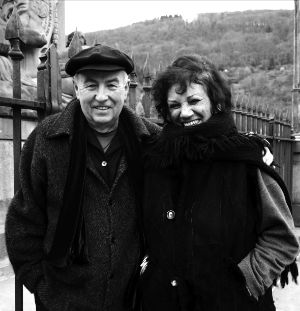
Karl Berger and Ingrid Sertso, Heidelberg 2005
© Wolke Verlag
i come from an art family, my mother was a classical pianist, my brother a pretty well known painter my other brother a jazz drummer, was in chet bakers european band. I left home when I was 17 years old, wanted to be a dancer but started singing with different european jazz groups, met karl in the famous cave 54 in heidelberg and we stayed together, worked together. we were twice at the berlin jazzfestival at the schwangeren auster and we loved it, once with don cherry, once with my brother klaus hagl and phantastic german and other european musicians, then we heared ornette coleman’s record, this is our music and we wanted to go to USA, where he is. we went to paris, met don cherry and went with him to america ... Meeting don and ornette made it clear to us that we were not so wrong to believe, music is in everybody, the musik mind. We loved nature, moved to woodstock and founded CMS together with ornette. karl had a doctors degree in musicology and was a phantastic teacher, he loved to teach. we still toured a lot all over the world. CMS was a meeting place for musicians from everywhere, turkey, africa, asia and so on. Karl’s musicmind was pure gold and he was loved, his words changed people’s life, i loved him, i love him and miss him and the pain of having lost him is beyond, he is not replaceable.
Ingrid Sertso about Karl Berger, excerpt from an e-mail
Impressions – Karl Berger and the Creative Music Studio
“When we were kids, we just played. It was intuitive. We were fully present in the moment. We still have that sense of intuitive flow – it is actually our natural way. We ‘play’ music.”
Karl Berger
3
(Un-)Learning to Play
In models of teaching music to children and young people ‘learning to play‘ can often mean unlearning how to play. Once school and formal training have been completed, music making that disregards results is often clouded by learnt theories, personal ambitions and academic pressure to succeed. But how can children be guided towards music and improvisation without narrowing their “natural” ability in the areas of playing and intuition? Two projects at this year’s Jazzfest Berlin that have been devised with and for children explore this question and put it to the test.
ImproCamp
In the Jazzfest ImproCamp children spend an entire week exploring the broad field of improvisation in a playful, interdisciplinary manner that does not require musical experience. Nadin Deventer, the Artistic Director of Jazzfest Berlin, talks to the director and musician Nelly Thea Köster and Jakob Fraisse, the Head of the German Jazz Union’s Department of Education & Research, about how the Jazzfest ImproCamp was conceived, about its challenges and the question of what those taking part can learn from the children.
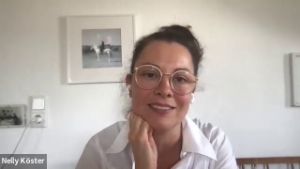
Apparitions
And a remarkable stage encounter on the opening day of the festival in the form of an adaptation of Novembre’s project “Apparitions” performed together with two Berlin children’s choirs demonstrates that playfulness and musical standards, the joy of improvisation and the finer points of composition by no means preclude each other. Romain Clerc-Renaud and Antonin-Tri Hoang from the ensemble Novembre and the choir directors Gudrun Luise Gierszal and Eva Spaeth will offer some insights into their work together while impressions of rehearsals provide an overview of their collaboration.
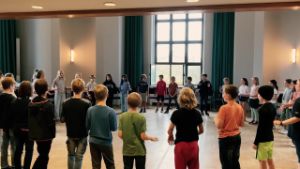
Subtitles are available in German and English. Turn on the subtitles by selecting the CC icon in the lower right corner of the player and choose a language.
The “Apparitions¨ concert including two children's choirs from Berlin
Contributors
Nadin Deventer
Nadin Deventer is artistic director of the Jazzfest Berlin since 2018. Under her artistic leadership the Jazzfest Berlin was nominated Festival of the Year 2020 and 2022 by the German Jazz Price and received the European Award for Adventurous Programming by the Europe Jazz Network in 2021.
Thomas Gläßer
Thomas Gläßer lives and works in Cologne and Berlin. A musician, program director and cultural activist, he founded the platform Zentrum für Aktuelle Musik e.V. alongside other musicians in 2006. In the field of current and contemporary music he has curated international concert series (Reconstructing Song, Reverse Exotism, Outskirts) and created festivals (Night of Surprise, Invocation, Digging the Global South, OLUZAYO) and conferences as well as artistic, pedagogic projects and local cultural and political initiatives.
He advises ensembles, institutions and associations (including Zinc & Copper, Jazzfest Berlin, Deutsche Jazzunion) and, as a board member of the Initiative Freie Musik IFM e.V., is one of the cultural policy spokespersons for the independent music scene in Cologne.
Brent Hayes Edwards
Brent Hayes Edwards is the co-author of Henry Threadgill’s autobiography, “Easily Slip into Another World: A Life in Music”, published in May 2023 by Knopf. Edwards is the Peng Family Professor of English and Comparative Literature at Columbia University (New York, USA), where he is also affiliated with the Center for Jazz Studies, and the editor of the journal PMLA. His other books include “The Practice of Diaspora: Literature, Translation, and the Rise of Black Internationalism” (2003), “Epistrophies: Jazz and the Literary Imagination” (2017) and the translation of Michel Leiris’s “Phantom Africa” (2017).
Christopher Hupe
Christopher Hupe works as a dramaturg for Jazzfest Berlin since 2019.
Harald Kisiedu
Harald Kisiedu is a musicologist, author, and musician. He is a lecturer at the Osnabrück University of Applied Sciences’ Institute of Music. His research interests include jazz as a global phenomenon, Afrodiasporic classical and experimental music, improvisation, and Wagner, and he has written on Peter Brötzmann, Muhal Richard Abrams, and Ernst-Ludwig Petrowsky among others. Kisiedu received his Ph.D. in historical musicology from Columbia University and also holds graduate degrees from the University of Hamburg. As a saxophonist, he has performed with Branford Marsalis, George Lewis, Henry Grimes, Hannibal Lokumbe, and Champion Jack Dupree and others.
In July 2023, his essay collection “Composing While Black: Afrodiasporic New Music Today” co-edited with George Lewis, was published by Wolke Verlag.
Peter Margasak
Peter Margasak is a long-time music journalist (for Chicago Reader, Rolling Stone and The New York Times, among others), who has also programmed the weekly Frequency Series at Constellation in Chicago since 2013. He works as a curatorial adviser for the Jazzfest Berlin.
Editors Jazzfest Berlin Story
Steffen Greiner, Chris Hupe, Vanessa Schaefer
